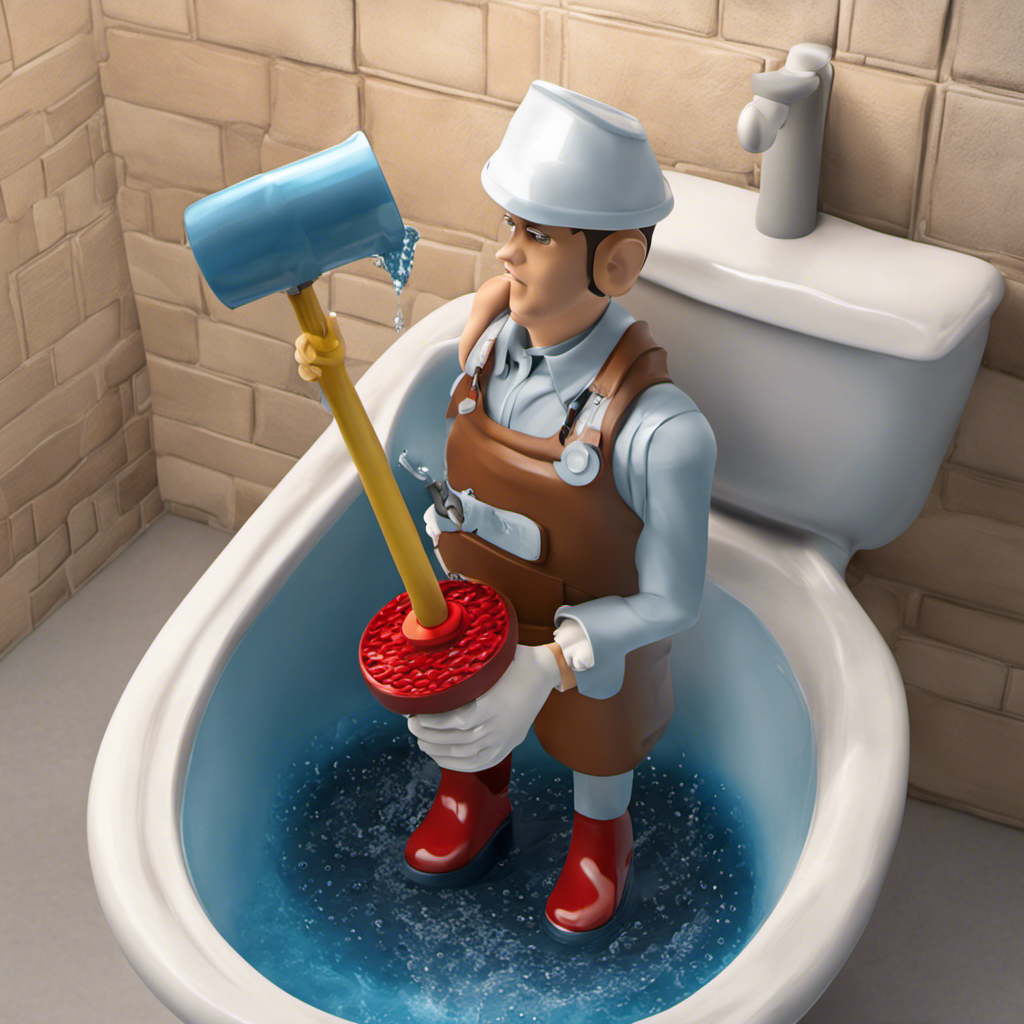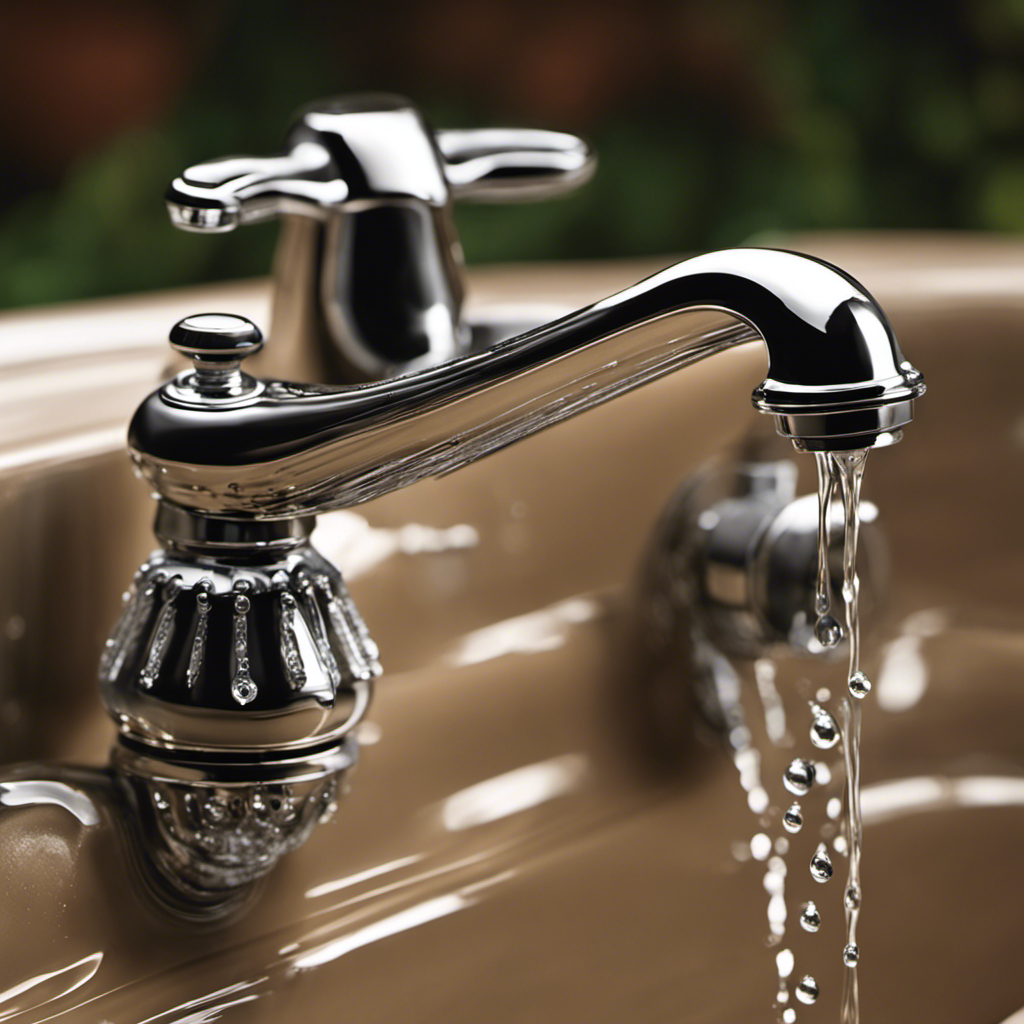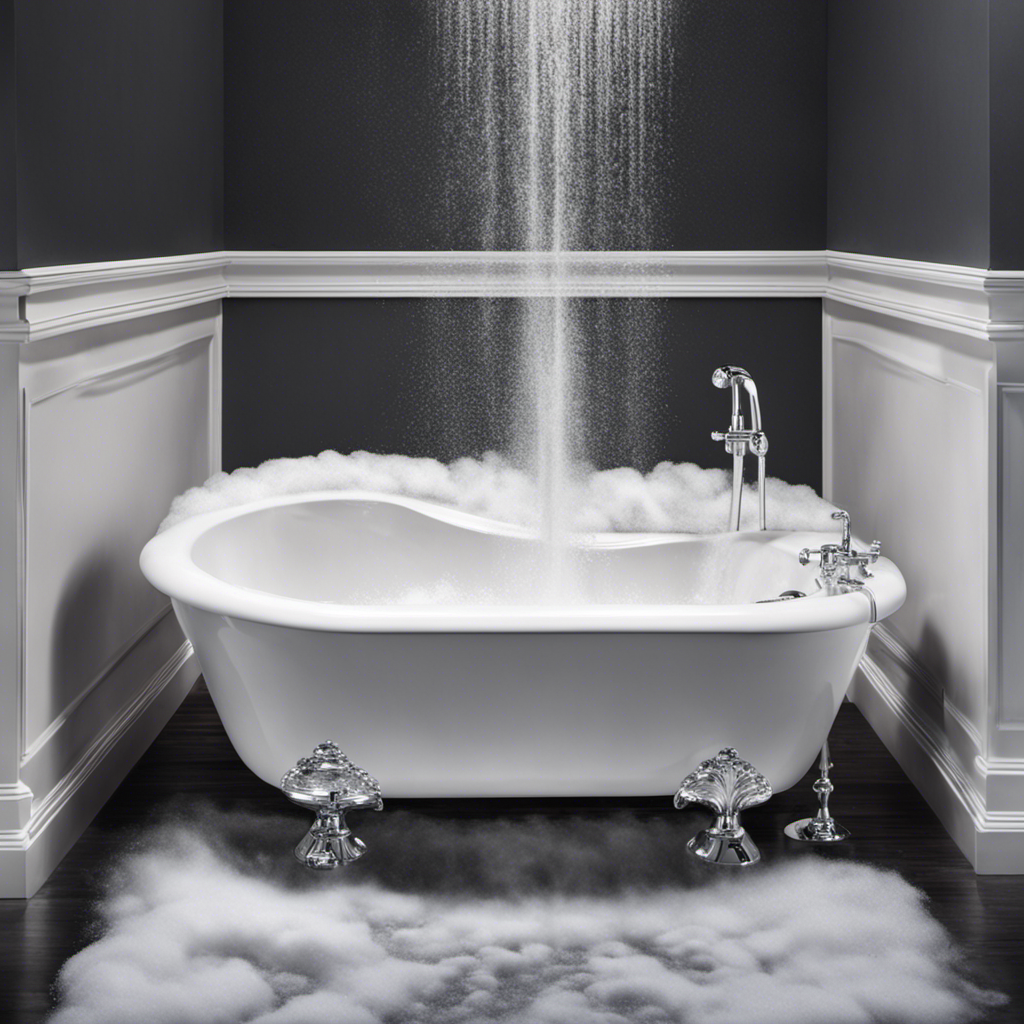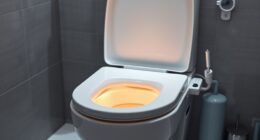I’ve been there before. Standing in the bathroom, staring at a clogged bathtub and feeling the frustration rise. But fear not, because I’ve got you covered.
In this article, I’ll walk you through the step-by-step process of unclogging your bathtub, from understanding the causes of clogs to using the right tools and techniques.
By the end, you’ll have the knowledge and confidence to tackle any stubborn clog that comes your way. So let’s get started and say goodbye to bathtub clogs once and for all.
Key Takeaways
- Hair accumulation and soap scum are common causes of bathtub clogs.
- Regularly cleaning the drain and using a drain strainer can help prevent clogs.
- Plungers and drain snakes are effective tools for unclogging a bathtub.
- If DIY methods don’t work or there are more serious issues, it’s best to seek help from a professional plumber.
Understanding the Causes of Bathtub Clogs
Understanding the causes of bathtub clogs can help you prevent future blockages. There are several common causes of bathtub blockage that you should be aware of.
One of the main culprits is hair. Over time, hair can accumulate in the drain and create a blockage.
Another common cause is soap scum and residue. When soap combines with minerals in the water, it can form a sticky residue that clogs the drain.
Other causes include foreign objects, such as toys or jewelry, and buildup of debris, such as dirt or skin cells.
To prevent these blockages, there are some simple solutions you can try. Installing a drain strainer can help catch hair and debris before they go down the drain. Regularly cleaning the drain with a mixture of vinegar and baking soda can also help remove soap scum and residue.
Finally, being mindful of what goes down the drain can prevent foreign objects from causing blockages.
Tools and Materials Needed for Unclogging a Bathtub
To successfully tackle this task, you’ll need a few tools and materials. Here are the essentials for bathtub maintenance and DIY solutions:
- Plunger: This tool creates pressure to dislodge clogs.
- Drain snake: A flexible coil that can reach deep into the drain to remove debris.
- Bucket: Used to catch water during the unclogging process.
- Rubber gloves: Protect your hands from any potential mess.
- Baking soda and vinegar: A natural and effective solution for breaking down clogs.
When it comes to bathtub maintenance and unclogging, having these tools and materials on hand is crucial. They will help you tackle clogs efficiently and prevent future issues.
Remember to always follow safety precautions and consult a professional if the problem persists. With the right tools and a bit of DIY know-how, you’ll have your bathtub running smoothly in no time.
Preparing the Bathtub for Unclogging
Make sure you’ve gathered all the necessary tools and materials before you begin preparing the bathtub for the unclogging process. Now, let’s dive into understanding common clogging mistakes and some tips for preventing future clogs.
To prepare the bathtub for unclogging, start by removing any visible debris or hair from the drain using a pair of needle-nose pliers or tweezers. Next, cover the overflow opening with a wet cloth or duct tape to create a seal. This will prevent any air from escaping and help create a stronger suction.
Before pouring any chemicals down the drain, it’s important to read the instructions carefully and wear protective gloves. Chemical cleaners can be effective but should be used with caution, as they can be harmful to your skin and pipes if not used correctly.
To prevent future clogs, avoid pouring grease, oil, or food scraps down the drain. Install a drain strainer to catch hair and other debris, and regularly clean it out. Additionally, flushing your drains with hot water and vinegar once a month can help break down any buildup and keep your pipes flowing smoothly.
Using a Plunger to Remove the Clog
Now let’s see how using a plunger can help remove the clog in your drain. When it comes to unclogging a bathtub, a plunger is one of the most effective tools you can use. Here are a few key tips for using a plunger properly:
- Ensure the plunger is in good condition and clean to prevent any damage to your drain.
- Make sure there is enough water in the bathtub to cover the plunger’s cup.
- Position the plunger over the drain and create a tight seal by pressing it firmly against the surface.
- Rapidly push and pull the plunger to create suction and dislodge the clog.
- Repeat this process several times until the water starts to drain properly.
While a plunger is a reliable tool, there are alternative unclogging methods that you can also consider. However, if the plunger doesn’t work, the next step is to learn how to snake a bathtub drain.
How to Snake a Bathtub Drain
When it comes to unclogging a stubborn bathtub drain, proper snaking techniques are essential.
As an experienced plumber, I have encountered many tough clogs that require the right approach.
In this discussion, I will guide you through the correct way to use a snake and share some effective tips for clearing even the most challenging clogs.
Proper Snaking Techniques
To properly snake the bathtub drain, you’ll need to insert the snake tool into the drain and rotate it in a clockwise motion. This technique helps to dislodge any clogs or debris that may be causing the blockage.
Here are some snaking tips and common mistakes to avoid:
- Use a snake tool with a flexible cable to navigate through the curves and bends of the drain pipe.
- Start with a gentle force and gradually increase the pressure to avoid damaging the pipes.
- Keep the snake tool straight and centered in the drain to ensure effective snaking.
- Rotate the snake tool in a clockwise motion to catch onto the clog and pull it out.
- Avoid excessive force or aggressive movements, as it can damage the drain pipes or push the clog further down.
Clearing Tough Clogs
Clearing tough clogs can be challenging, but with the right tools and techniques, you can successfully remove any stubborn blockages in your drain.
When it comes to clearing stubborn clogs, there are several effective home remedies that you can try. One popular method is using a combination of baking soda and vinegar.
Baking soda is a natural cleaner and deodorizer, while vinegar is a powerful disinfectant. To clear a tough clog, start by pouring a cup of baking soda down the drain. Follow this with a cup of vinegar and immediately cover the drain with a plug or rag to contain the fizzing reaction.
Let the mixture sit for about 30 minutes, then flush it with hot water. This method is effective in breaking down stubborn clogs and can be a great first step before resorting to harsh chemicals or calling a plumber.
Unclogging a Bathtub With Baking Soda and Vinegar
Using baking soda and vinegar is an effective way to unclog a bathtub. This natural remedy is a great alternative to using a plunger. Here’s how to do it:
- Start by removing any standing water from the tub.
- Pour one cup of baking soda directly into the drain.
- Follow it up with one cup of vinegar.
- Quickly cover the drain with a plug or cloth to contain the fizzing reaction.
- Let the mixture sit for about 30 minutes.
- After waiting, remove the cover and flush the drain with hot water.
The combination of baking soda and vinegar creates a chemical reaction that helps break down and dissolve the clog. This method is not only effective but also environmentally friendly, as it avoids the use of harsh chemicals.
Give it a try before reaching for commercial drain cleaners!
Using Chemical Drain Cleaners Safely and Effectively
When it comes to using chemical drain cleaners safely and effectively, there are two key points to keep in mind: proper chemical usage and safety precautions.
It is crucial to follow the instructions provided by the manufacturer and never mix different chemicals together, as this can result in dangerous reactions.
Additionally, wearing protective gear such as gloves and goggles is essential to prevent any potential harm from coming into contact with the skin or eyes.
Proper Chemical Usage
To effectively unclog a bathtub, it’s important to use the proper chemicals. Chemical drain cleaners can be effective in breaking down clogs and restoring the flow of water. However, it is essential to prioritize chemical safety when using these products. Here are some key points to keep in mind:
- Read and follow the instructions on the label carefully.
- Wear protective gloves and goggles to avoid any contact with the chemicals.
- Work in a well-ventilated area to minimize exposure to fumes.
- Never mix different drain cleaners or other chemicals together.
- Consider alternative solutions like using a plunger or a drain snake before resorting to chemical cleaners.
Safety Precautions
It’s essential to prioritize safety when working with chemical drain cleaners in order to avoid any potential risks or damage. When dealing with bathtub clogs, safety precautions should be taken to prevent injuries.
First and foremost, it is crucial to wear protective gear such as gloves and safety goggles to shield yourself from any potential splashes or fumes. Additionally, make sure to work in a well-ventilated area to minimize the inhalation of any harmful chemicals.
When using the drain cleaner, carefully follow the instructions provided by the manufacturer and avoid mixing different types of cleaners, as this can lead to dangerous chemical reactions. It’s also important to keep children and pets away from the area during the cleaning process.
Removing and Cleaning the Bathtub Drain Stopper
You can start by twisting the bathtub drain stopper counterclockwise to remove it. Once the stopper is out, you’ll be able to access the drain and clean it thoroughly.
Here are some steps to follow for an effective cleaning process:
- Use a natural cleaning product, such as a mixture of baking soda and vinegar, to break down any buildup or clogs in the drain.
- Scrub the drain with a small brush or toothbrush to remove any remaining debris or residue.
- Rinse the drain with hot water to flush out any loosened particles.
- For stubborn clogs, consider using a plunger or a drain snake to dislodge the blockage.
- After cleaning, replace the drain stopper by twisting it back into place clockwise.
Preventative Maintenance Tips to Avoid Bathtub Clogs
Regularly maintaining your bathtub drain is essential for preventing clogs and ensuring a smoothly functioning plumbing system. By following a few simple bathtub clog prevention tips, you can avoid the frustration and inconvenience of dealing with a clogged drain.
One of the most common causes of bathtub clogs is the accumulation of hair and soap scum. To prevent this, use a drain strainer to catch hair and debris before they enter the drain. Additionally, regularly cleaning the drain stopper and removing any built-up residue can help prevent clogs.
Another common cause of bathtub clogs is the buildup of mineral deposits and sediment. To prevent this, consider using a water softener or installing a water filtration system to reduce the amount of mineral buildup in your plumbing system.
Taking these preventative measures will help keep your bathtub drain running smoothly and avoid costly plumbing repairs.
Hiring a Professional for Stubborn Bathtub Clogs
Hiring a professional can be a wise choice when dealing with stubborn clogs in your bathtub. While DIY bathtub unclogging methods can work for minor clogs, more severe blockages may require the expertise of a plumber.
Here are a few reasons why hiring a plumber is the best option:
- Experience: Plumbers have the knowledge and experience to identify the root cause of the clog and determine the most effective solution.
- Proper Tools: Plumbers have access to specialized tools and equipment that can effectively remove stubborn clogs without causing damage to your pipes.
- Time-saving: Hiring a plumber saves you time and effort. They can quickly diagnose and fix the problem, allowing you to get back to your daily routine.
- Long-term Solutions: Plumbers can provide long-term solutions to prevent future clogs, saving you from recurring issues.
- Safety: Dealing with clogs can be messy and potentially hazardous. Plumbers have the necessary training and expertise to handle the situation safely.
Troubleshooting Common Issues in Bathtub Unclogging
If you’re experiencing frequent drainage problems in your tub, it might be due to a buildup of hair and soap scum in the pipes. To tackle this issue, there are several bathtub drain cleaning tips and DIY bathtub unclogging methods that you can try. These methods are cost-effective and can save you from the hassle of calling a professional plumber. Here is a table outlining some effective DIY methods to unclog your bathtub:
| Method | Materials Needed | Steps |
|---|---|---|
| Boiling Water | Kettle, Hot Water | 1. Boil water in a kettle. 2. Pour the boiling water directly into the drain. |
| Baking Soda and Vinegar | Baking Soda, White Vinegar, Hot Water | 1. Pour half a cup of baking soda into the drain. 2. Follow it with half a cup of white vinegar. 3. Let it sit for 30 minutes. 4. Rinse with hot water. |
| Plunger | Plunger | 1. Cover the overflow drain with a wet rag. 2. Place the plunger over the drain and plunge vigorously. |
These DIY methods can effectively unclog your bathtub and restore proper drainage. However, if the clog persists or if you are unsure about performing these methods, it is recommended to seek professional help.
Frequently Asked Questions
Can I Use a Plunger to Unclog a Bathtub if I Have a Shower Head Attachment?
Yes, you can use a plunger to unclog a bathtub even if you have a shower head attachment. However, there are also other plunger alternatives available, such as using hot water to help clear the clog.
Is It Safe to Use Chemical Drain Cleaners if I Have a Septic System?
Using chemical drain cleaners with a septic system can be risky. The harsh chemicals can harm the beneficial bacteria in the septic tank. It’s best to avoid them and opt for alternative methods to unclog your bathtub.
How Often Should I Clean and Remove the Bathtub Drain Stopper?
I clean and remove the bathtub drain stopper once every few months. It’s important to keep it free from hair and debris to prevent clogs. Using a plunger with a shower head attachment is not recommended for unclogging a bathtub.
Can I Use Baking Soda and Vinegar to Unclog a Bathtub if I Have PVC Pipes?
Can baking soda and vinegar effectively unclog a bathtub with PVC pipes? Is there a risk of damaging the pipes? As a plumbing expert, I’ll explain the effectiveness and potential risks involved.
What Should I Do if the Snake Gets Stuck in the Bathtub Drain?
If the snake gets stuck in the bathtub drain, it’s important to avoid causing further damage. I would recommend seeking professional help for snake removal to ensure the issue is resolved safely and effectively.
Conclusion
In conclusion, battling a clogged bathtub can be a frustrating experience, but fear not! Armed with the right tools and knowledge, you can conquer this plumbing obstacle like a seasoned warrior.
Whether you need to plunge, snake, or clean out the drain stopper, there is a solution for every clog.
By taking preventative measures and seeking professional help when needed, you can ensure a smooth flow in your bathtub for years to come.
So don’t let that clog rain on your parade, take charge and reclaim your bath time sanctuary!










